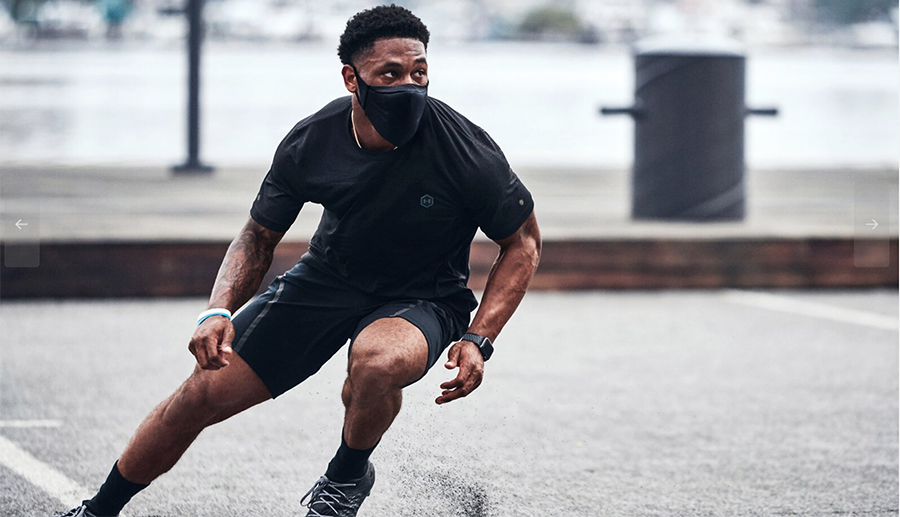Under Armour Inc. reported fourth-quarter results that blew past Wall Street estimates due to better-than-expected sell-throughs and full-price selling. However, officials provided a cautious sales outlook for 2021 as the company seeks to “constrain demand” to reestablish Under Armour’s position as a premium-priced brand.
On a conference call with analysts, Patrik Frisk, president and CEO, highlighted the progress Under Armour is making with its lengthy transformation efforts in the face of a pandemic that is expected to lead to a return to profitability in 2021. Over the last year, these steps include relaunching its North American e-commerce platform, divesting MyFitnessPal, rebalancing its cost structure in line with revenues, and improving execution across the business.
But he also said the pandemic continues to create uncertainty in the marketplace, and it’s uncertain how changes in behavior caused by the pandemic will impact the business.
“We remain focused on controlling what we can while staying prudent,” said Frisk. “This means being patient and measured and how we manage our business and conscious about where we are within our journey while maintaining the same level of discipline that got us here. To this effect, we will continue to constrain demand in 2021, a decision that, as discussed in previous calls, may impact our ability to drive top-line volume in the near term. However, whether through proactive wholesale door reduction efforts in North America or ordering slightly less product against future demand, based on the brand and margin benefits that we realized in 2020, we are confident that this focus will help elevate our premium positioning with consumers and therefore driving better profitability.”
Frisk said Under Armour remains committed to four areas of focus introduced on its third-quarter conference call. These include:
- Continuing to strengthen the brand through increased engagement and consideration with the focused performer;
- Continuous improvement within its operating model to drive greater efficiency across all end-to-end processes;
- Elevating a direct-to-consumer focused approach to deepen and amplify its connection with Under Armour consumers; and
- Getting back to profitable growth in 2021 and making sure its newfound discipline stays aligned with driving shareholder value over the long term.

High-Single-Digit Growth Projected For 2021
For 2021, Under Armour expects a high-single-digit rate increase in sales for the full year, reflecting a high-single-digit increase in North America and high-teens growth internationally; however, the growth is expected to be driven by the first quarter, when sales are projected to jump approximately 20 percent.
The current quarter is projected to benefit from a previously-announced shift of about $130 million of orders out of the fourth quarter into the first due to timing impacts from COVID-19 to customer order flow and changes in supply chain timing. That translates primarily into flat growth for the remaining three quarters of the year.
On the call, Dave Bergman, CFO, said that beyond efforts to “constrain orders against the expected demand,” the company faces several other revenue headwinds in 2021, including the divesture of MyFitnessPal.
Another factor is Under Armour’s plans to disclose on its third-quarter conference call to begin to exit certain undifferentiated wholesale distribution, primarily in North America, starting the back half of 2021. The goal is to leave about 2,000 to 3,000 wholesale partner doors closer to 10,000 doors by the end of 2022. Sales will be impacted by several changes to its operating model in Latin America, including shifting certain countries to strategic distributorship models. The moves promise to impact revenue negatively but boost operating margins.
From a channel perspective, Under Armour has “limited visibility” into wholesale bookings for the back half of the year as third-quarter bookings are finalized and fourth-quarter bookings only recently started. E-commerce is expected to face difficult comparisons in 2021 against pandemic-driven buying. Retail is expected to outpace online gains this year.
Frisk stressed the overall cautious back-half outlook underscores a newfound discipline around tightening initial buys and limiting at-once capabilities to ensure inventories are aligned to support premium selling. The CEO added, “So there won’t be a situation, even if it opens up, where we will go and chase, apart from the inventories that we have. And that’s an important strategy for us going forward.”
Fourth-Quarter Tops Wall Street Targets
In the fourth quarter, net income reached $184 million, or 40 cents a share, against a loss of $15.3 million, or 3 cents, a year ago. Excluding non-recurring items, adjusted net income was $55 million, or 12 cents, topping Wall Street’s adjusted estimate calling for a loss of 7 cents.
Revenues were down 2.6 percent to $1.4 billion. Wall Street’s consensus estimate had been $1.27 billion. Results were better than expected due to higher than anticipated demand across wholesale and direct-to-consumer (DTC) businesses.
Wholesale revenue was down 12 percent, in part reflecting the shift of $130 million in orders to the first quarter. Relative to plan, stronger sell-through and higher demand from wholesale accounts was seen. DTC increased 11 percent, driven by 25 percent growth in e-commerce. Better-than-expected traffic trends in retail were also seen.
Licensing sales were down 12 percent, driven primarily by lapping one-time settlements in the prior year with two of its North American partners and lower minimum royalty payments. The result was better than expected, driven primarily by its Japanese partner.
By product type, apparel revenue was down 4 percent due to declines in train and team sports categories. Footwear fell 7 percent, mainly driven by declines in team sports. Accessories jumped 32 percent, with all of the growth driven by Sportsmasks.
North America Q4 Sales Down 6 Percent
From a regional perspective, North America dropped 6 percent in the quarter, negatively impacted by the COVID-19 timing impacts to the supply chain and reduced off-price sales. These headwinds were partially offset by strengthened e-commerce within DTC in the quarter.
In the EMEA region, revenues were down 11 percent, negatively impacted by COVID-19 timing impacts partially offset by solid growth within its DTC business primarily due to e-commerce. Revenue in the Asia Pacific was up 26 percent, driven by growth across all channels, partially offset by COVID-19 timing impacts. In Latin America, revenue was up 2 percent as DTC growth, which included strength in e-commerce, offset COVID-19 impacts. Connected Fitness sales were down 5 percent due to the My Fitness Pal platform’s sale in mid-December.
Companywide gross margins increased 210 basis points to 49.4 percent. Excluding restructuring charges, adjusted gross margin increased 300 basis points to 50.3 percent, driven by approximately 150 basis points of favorable channel mix benefiting from a lower year-by-year distributor and off-price sales and a heavier mix towards DTC. Additional year-over-year increases included 90 basis points of supply chain benefits, primarily driven by product cost improvements and 30 basis points of a positive regional mix, driven by APAC growth in the quarter,
Gross margins were significantly better than expected due to higher than anticipated demand that led to “considerably less discounting and markdowns than we had initially anticipated,” said Bergman.
SG&A expense decreased 4 percent to $586 million due to restructuring efforts and tighter spend management. Restructuring and impairment charges were $52 million in the latest quarter, consisting of $50 million of restructuring and related impairment charges and $2 million of long-lived asset impairments.
Operating income in the quarter was $56 million. Excluding restructuring and impairment charges, adjusted operating income was $120 million.
For the full year, Under Armour’s revenue was down 15 percent to $4.5 billion. The net loss came to $549.2 million, or $1.21, against earnings of $92.1 million, or 20 cents, a year ago. The adjusted net loss was $120 million, or 26 cents. Inventory was relatively unchanged at year-end.

Under Armour’s Four Areas Of Focus
Elaborating on the company’s four strategic priorities, Frisk highlighted the strong response to the launch early last year of its “The Only Way Is Through” campaign adjusted for the pandemic.
“From The Only Way is Through to Through this Together and other variations along the way, we refocused our efforts more surgically to drive greater returns amid an exceedingly dynamic environment,” said Frisk. “And while these efforts take time to manifest to see change, exiting a year like 2020 with increased consideration, conversion and higher selling prices in many parts of our business give us greater confidence in our strategy and execution for the year ahead.”
On the product front, strong launches were seen for its Project Rock Collection, Meridian pant, Infinity Bra, UA Sportsmask, the HOVR Machina, Phantom 2, and the Breakthru in footwear. Said Frisk, “One highlight we’re especially encouraged by is the continued momentum in our women’s business, specifically bras and bottoms, and broad-based interest across our run category, led by our innovation-driven HOVR franchise.”
He highlighted UA’s December launch of the Curry Brand and the introduction of the Curry 8 basketball shoe that was the first to feature UA Flow, its second cushioning technology released under the brands’ reengineered, go-to-market strategy. This year, the UA Flow will be introduced to running models to “help drive even more significant consideration and authenticity with core runners,” as well as help secure shelf space at running specialty and key wholesale accounts.
On its second priority of furthering driving efficiencies within its operating model, Frisk said Under Armour has rebased its cost structure to be in a position to return to a double-digit operating margin over the long term. Steps to streamline its cost base include focusing on “future cost avoidance leverage,” referencing the exiting of marketing contracts that weren’t delivering the return as expected. Over the last year, the brand ended contracts with UCLA, the University of California, Berkeley, and the University of Cincinnati and reached an agreement to end its on-field licensing contract with the NFL.
Investments will still be made in marketing, IT and elevating its international and DTC footprints, but greater discipline is being placed on ROI. Inventory commitments are likewise being planned “even more tightly, helping us drive fuller-price selling across all distribution points while keeping an eye on increasing our productivity and therefore returns.”
On elevating the DTC-focused approach, Frisk noted that e-commerce was up 40 percent in 2020, representing nearly half of the total DTC business. The focus online this year will be on improving personalization. Full-price Brand House locations will prioritize “more profitable formats” while factory outlets will improve productivity and reduce promotional levels. Drop-ship, endless aisle and RFID capabilities are being tapped to further an omnichannel approach to DTC.
Finally, ensuring a commitment to profitable growth is expected to be the payback from the first three key areas of focus. Said Frisk, “It’s well understood across the enterprise what we must do as we work to deliver greater leverage and sustainable, profitable growth over the long term.”
Outlook For 2021
The outlook for 2021 includes:
- Revenue to be up at a high-single-digit percentage rate, reflecting a high-single-digit growth rate in North America and a high-teens growth rate in the international business;
- Gross margin to be up slightly versus an adjusted gross margin rate of 48.6 in 2020 with benefits from pricing and supply chain efficiency, being primarily offset by the sale of MyFitnessPal;
- Operating income to reach $5 million to $25 million. Excluding the impact of continued restructuring efforts, adjusted operating income is expected to reach $130 million to $150 million compared with $537,000′; and
- Diluted loss per share is expected to be 18 cents to 20 cents per share, and adjusted diluted EPS is expected to range from 12 cents to 14 cents.
For the first quarter:
- Revenue to be up approximately 20 percent due to the shift of $130 million of orders from the fourth quarter;
- Gross margins to be up about 180 basis points to 200 basis points, driven primarily by pricing benefits related to lower promotions, primarily in DTC and continued supply chain benefits associated with product costing improvements;
- The first quarter to show an operating loss of approximately $55 million to $70 million. Excluding planned restructuring impacts, adjusted operating income is projected in the range of $30 million to $35 million.
- Excluding restructuring, adjusted EPS is projected to be 3 cents.
Photos courtesy Under Armour
















